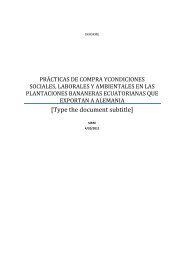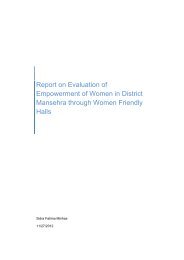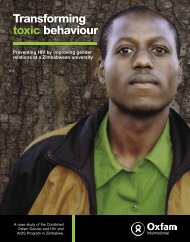No Time to Lose - Oxfam
No Time to Lose - Oxfam
No Time to Lose - Oxfam
Create successful ePaper yourself
Turn your PDF publications into a flip-book with our unique Google optimized e-Paper software.
The AIHRC is yet <strong>to</strong> receive any funding from the government, and<br />
for several months in 2010 was unable <strong>to</strong> pay its staff. 106<br />
The 2010 National Police Strategy contains an explicit commitment <strong>to</strong><br />
establishing independent, external oversight of the police 107 – and the<br />
most serious effort in this regard is the EUPOL-supported police ombudsman’s<br />
office, which sits within the AIHRC. The objective of the<br />
ombudsman’s office is <strong>to</strong> moni<strong>to</strong>r the performance of the ANP and <strong>to</strong><br />
investigate alleged serious violations of human rights. The initiative<br />
is in its early stages, and it will be some time before it is possible <strong>to</strong><br />
assess its effectiveness. Issues <strong>to</strong> watch will include the adequacy and<br />
sustainability of funding for the AIHRC, the political will of the MoI,<br />
the need for a clear division of competencies between the ombudsman’s<br />
office and existing oversight bodies, the practical accessibility<br />
of the ombudsman <strong>to</strong> communities in rural areas, and whether the<br />
ombudsman is given oversight over all pillars (and sub-pillars) of the<br />
ANP – including, critically, the ALP.<br />
Military Justice Reform<br />
The development of Afghanistan’s military justice system appears, on<br />
paper, <strong>to</strong> be one of the more positive examples of progress <strong>to</strong>wards<br />
enhancing the accountability of the ANSF. The last six years have<br />
seen the development of the Military Crimes Code, the ANA Law of<br />
Military Courts and the Military Criminal Procedure Code, as well as<br />
Disciplinary Regulations. The Law of Military Courts creates primary<br />
military trial courts and a court of military appeals, and defers <strong>to</strong> the<br />
Supreme Court of Afghanistan as its highest appellate authority. 108<br />
The system is generally regarded as ‘reasonably functional’ – with<br />
courts, judges, prosecu<strong>to</strong>rs and defence counsel present and functioning<br />
in each of the regional commands. 109<br />
But while the system itself is reasonably functional, it is seriously undermined<br />
by its position within the military command structure and<br />
vulnerability <strong>to</strong> political influence. As described by a senior ISAF official,<br />
‘the system is schizophrenic; it’s basically functional for junior<br />
ranking officials and those who aren’t connected, but has almost no<br />
application <strong>to</strong> Lieutenant Colonels and above.’ 110 It’s a far cry from<br />
the ‘effective program <strong>to</strong> prevent violations of the law of war’ required<br />
by US Department of Defense policy.<br />
The problem is mainly <strong>to</strong> do with power and patronage, but there are<br />
also structural issues that make the abuse of power possible. In each<br />
of the six regional commands, there is a legal office comprised of legal<br />
officers, defence counsel, prosecu<strong>to</strong>rs, judges and a criminal investigations<br />
department (CID). The legal offices report <strong>to</strong> the Corps Commanders.<br />
While commanders are required by law <strong>to</strong> refer crimes<br />
committed under their command <strong>to</strong> the legal office for investiga-<br />
24







![Download: Faltposter EU-Handelspolitik [PDF 2,17MB] - Germanwatch](https://img.yumpu.com/25095854/1/190x161/download-faltposter-eu-handelspolitik-pdf-217mb-germanwatch.jpg?quality=85)








